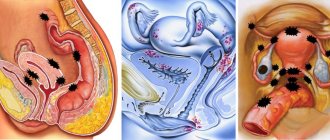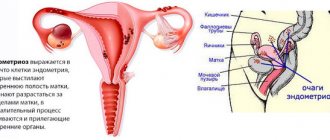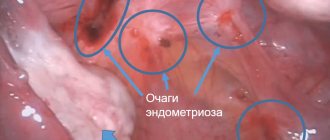The female body regularly undergoes cyclical changes. Thus, one calendar month can be divided into several different periods. Recently, hormonal diseases (endometritis, endometriosis, adenomyosis, and so on) have become increasingly common. Every year, one or another pathology affects millions of women around the world. This article will tell you what adenomyosis and endometriosis are. What is the difference between these pathologies? You will find out the answer to this question further. It is also worth mentioning what treatment is prescribed for such a disease as adenomyosis (symptoms and causes of adenomyosis will also be described below), how it differs from the correction of endometriosis.
Hormonal diseases
Since a woman’s body regularly undergoes hormonal changes, sometimes disruptions occur. Most often this occurs after childbirth, abortion and diagnostic curettage. Also, hormones can be “naughty” during menopause and before menopause.
The most common and insidious hormonal diseases are endometriosis and adenomyosis. The difference between them is significant. However, many women confuse these pathologies. It is worth noting that adenomyosis is sometimes called internal endometriosis. Let's try to figure out how these pathologies are similar and how they differ.
Main similarities and differences between diseases
The difference between endometriosis and adenomyosis lies in the following factors:
- Location of the lesion. With adenomyosis, pathological changes do not spread beyond the uterus. The endometrium penetrates muscle tissue, but does not spread to nearby organs. In endometriosis, endometrioid cells are found in the fallopian tubes, peritoneum, ovaries, intestines and bladder.
- Clinical picture. Women diagnosed with adenomyosis experience pain during or after sexual intercourse. The menstrual cycle shortens, bleeding becomes prolonged and heavy. With severe hormonal imbalance, spotting is observed, regardless of the phase of the cycle. Symptoms of endometriosis appear in the later stages of the disease. Most often, the diagnosis is made at the stage of development of endometrioid cysts.
- Diagnostic methods. To identify adenomyosis, a gynecological examination, colposcopy, smear tests and diagnostic curettage are used. Additionally, ultrasound is used to help determine the size and number of pathological foci. It is impossible to detect endometriosis using these procedures. The only effective diagnostic method is laparoscopy.
- Methods of treatment. For adenomyosis, hormonal therapy is performed to suppress the synthesis of estrogen. Additionally, an artificial analogue of progesterone is introduced. In severe cases of the disease, surgical treatment is performed - removal of the uterus. Excess of the endometrium outside the uterus can only be treated surgically. Pathological lesions are removed laparoscopically. The introduction of hormones in most cases does not produce results.
- Complications. Adenomyosis leads to permanent enlargement of the uterine body, which may require removal of the organ. Endometriosis differs from adenomyosis in the development of bleeding and adhesions, fusion of the pelvic organs.
The diseases have similar causes. Both pathologies refer to diseases that develop against the background of hormonal disorders. They lead to menstrual irregularities and inability to conceive. Infertility with internal and external forms of endometriosis occurs due to obstruction of the fallopian tubes. The release of the egg into the uterine cavity and its fertilization becomes impossible. Infertility with adenomyosis develops due to the appearance of adhesions that reduce the mobility of the fallopian tissues.
https://youtu.be/Xw5q4dt7DIM
Endometriosis
How is endometriosis different from adenomyosis? This pathology occurs as follows. Due to the high production of estrogens or androgens, the mucous layer of the uterus grows into the peritoneal area. The disease can also occur due to the fact that menstrual blood is thrown through the fallopian tubes into the retrouterine space.
All this leads to the fact that the endometrium begins to function on the ovaries, body of the uterus, intestines and other nearby organs. Subject to cyclical changes, this substance can menstruate, like the internal cavity of the reproductive organ.
Endometriosis pathology
With endometriosis, cells in the lining of the uterus spread beyond the organ, affecting nearby tissue. Diseases of this nature are often found among women of childbearing age.
The mechanism of their development includes:
- Hormonal disbalance. The production of progesterone is disrupted and its metabolism changes. With endometriosis, an increase in the level of hormones of the first phase of the cycle is detected, which contribute to increased growth of the endometrium. Less commonly, changes in the amount of prolactin and adrenal hormones in the female body are detected.
- Violation of cell division and death. Increased production of internal growth factor leads to vasodilation and proliferation of endometriosis foci. The activity of killer cells decreases, the processes of natural renewal of endometrial tissue are disrupted.
- Spread of the mucous lining of the uterus beyond the organ. With menstrual blood, glandular cells penetrate the fallopian tubes, where they continue to function. This is how the external form of the disease arises. When cells of the mucous layer grow into the muscle layer, internal endometriosis develops.
Symptoms of endometriosis
There are several stages of the disease. Depending on the lesion and location of the outbreak, a woman may have absolutely no complaints even at the very last stage of the disease. That is why pathology is considered very dangerous and insidious. So, the signs of endometriosis are as follows:
- abdominal pain during menstruation and a few days before it;
- stool disorders (in case of intestinal damage);
- irregular cycle with breakthrough bleeding;
- long periods that turn black at the end;
- long-term inability to conceive a child.
Endometriosis: the essence of the disease and its causes
The inside of the uterine cavity is lined with a special tissue - the endometrium. Endometrial cells are sensitive to the menstrual cycle . They grow, thicken, and once a month they are destroyed and removed from the body with the blood.
The disease is said to occur when the endometrium, growing through the wall of the uterus, affects neighboring tissues, or spreads through the bloodstream to other organs and systems. At the same time, the cells continue to live in their usual rhythm: grow and bleed regularly, which provokes the appearance of chocolate-colored cysts.
The exact reasons for the development of endometriosis are not clear ; there are only theories about predisposing factors:
- failure in the production and ratio of sex hormones;
- surgical interventions that promote the growth of the endometrium into the body of the uterus and its casting into the abdominal cavity (abortion, cesarean section);
- genetic predisposition.
Attention! A major role is played by decreased immunity and excessive physical and psycho-emotional stress.
The development of endometriosis occurs in 4 stages :
- The presence of several shallow lesions that do not manifest themselves clinically and do not threaten the normal functioning of the body.
- Growth of the endometrium deep into the affected organ. It is during this period that symptoms may appear.
- Multiple foci of varying degrees of damage. Deviations in the functioning of the pelvic organs occur, tumor-like formations and cysts are detected.
- The capture of other organs by the endometrium becomes widespread, the tissue is affected to its full depth. Benign tumors and their degeneration are observed in large numbers.
At the initial stage, endometriosis develops asymptomatically . Often, a woman notices the first signs only when cysts form, an increase in the size of the affected organ and its bleeding in accordance with the menstrual cycle, pain in areas of focal growth. Inflammation, an increase in local and general temperature, and anemia may develop.
Fortunately, endometriosis, in its full manifestation, does not develop so often. Usually there is a “lighter” form of it – adenomyosis.
Adenomyosis
Adenomyosis and endometriosis: what is the difference? Many doctors say that endometriosis can be internal. In this case, it is called “adenomyosis.” The disease develops as follows. Due to an imbalance of estrogen and progesterone, an excess of the former substances may be observed in the body. As a result, the inner surface of the uterus grows profusely. In the absence of timely and correct treatment, the endometrium penetrates into the muscular layer of the reproductive organ. Endometriosis of the uterus - adenomyosis. Many women think so. In some ways they are right. However, each pathology has its own name and it would be more correct to use it.
Similarity of pathologies
Difficulties in recognizing adenomyosis and endometriosis lie in the many similarities in their development, symptoms, and treatment methods. Thus, both pathologies occur exclusively in the female part of the population - as a rule, due to hormonal imbalance in their body. A negative hereditary predisposition plays a huge role in this.
In addition, both diseases tend to recur - even after seemingly successful therapy, unpleasant clinical signs may reappear. The timing of the resumption of symptoms varies - from several months to several years. Experts do not provide guarantees of complete recovery.
The methods of treating adenomyosis and endometriosis also have similarities: first, drug therapy, always including hormonal drugs in the regimen, then, if there is no positive result from taking the drugs, one of the surgical intervention methods is selected, up to hysterectomy.
Both pathologies pose a threat to a woman’s reproductive system – her chances of becoming a mother.
Indeed, due to the lack of early symptoms, diseases are diagnosed late, when natural conception may become impossible. Expensive, lengthy treatment is required, including in vitro fertilization.
Endometriosis and adenomyosis: the difference
How do these pathologies differ? As you already know, adenomyosis is internal endometriosis of the uterine body. Can we say that these are the same thing? More likely no than yes. If we are talking about ordinary (not internal) endometriosis, then how does it differ from the growth of the mucous membrane of the reproductive organ? Let's try to draw a parallel between pathologies and find out what the difference is between them.
Place of education
Endometriosis is a pathology that most often affects the fallopian tubes, the outer lining of the uterus, intestines and other organs.
Adenomyosis develops exclusively in the reproductive organ. Even after growing into the muscular layer of the uterus, the endometrium does not extend beyond its boundaries.
Symptoms of the disease
If we compare adenomyosis and endometriosis, what is the difference between the diseases? Judging by the symptoms, the differences will be as follows. Endometriosis develops gradually and may not be noticeable for a long time. In some women, the disease is diagnosed only at the last stage, when endometriomas (cysts) appear.
Adenomyosis most often makes itself known immediately. Symptoms include prolonged periods, painful sensations, and so on.
Diagnosis of the disease
Endometriosis cannot be diagnosed with 100% accuracy. A doctor can only suspect and assume that you have a pathology. Even an ultrasound examination cannot reliably make a diagnosis. You can absolutely find out about the presence of the disease after laparoscopy (diagnostic surgery).
Adenomyosis can in most cases be diagnosed during ultrasound and hysteroscopy. Also, experienced gynecologists can make a diagnosis after examination in a gynecological chair.
Treatment of pathology
Endometriosis can be corrected surgically with great effectiveness. During the operation, the doctor removes or cauterizes foci of pathological endometrium. Conservative therapy can be effective only in the initial stages of the disease.
Adenomyosis is most often treated with medication. In most cases, these are hormonal drugs that suppress the production of estrogens and androgens. Progesterone is also prescribed during treatment.
Consequences
Endometriosis can cause irreparable damage to the health of the fairer sex. During menstrual-like internal bleeding, fluid thickens and adhesions form. All this, if left untreated, leads not only to infertility, but also to fusion of the abdominal organs.
Adenomyosis is also quite dangerous, but it does not affect the organs of the peritoneum, affecting exclusively the muscular layer of the uterus.
Features of the pathology of adenomyosis
In order to understand how adenomyosis differs from endometriosis, it is necessary to study brief information about these diseases.
This diagnosis is made if an ultrasound scan reveals a focal proliferation of cells in the uterine mucosa. No malignant degeneration of cells is observed.
Typical symptoms are an enlarged uterus, heavy menstruation and lower abdominal pain.
Most often, pathology is detected in mature and elderly patients. The mechanism of development of adenomyosis includes:
- Germination of endometrial glandular cells into connective tissue fibers separating the functional layer from the muscle layer. Over time, cells from the lining of the uterus penetrate the muscular walls of the uterus. With adenomyosis, the pathological process does not cover the entire organ. The lesion is focal in nature.
- Inflammatory process. In response to the introduction of endometrioid tissue, the muscular layer of the uterus begins to thicken. Pathological changes are also focal in nature. Dense muscle fibers delimit foreign tissue, preventing the spread of ingrowth.
- Enlarged uterus. Benign neoplasms form in the thickness of the muscle tissue, causing the uterus to enlarge and acquire a rounded shape.
Clinical symptoms
The main difference between adenomyosis and endometriosis is the prevalence of the pathological process. Growing foci of the uterine mucosa do not extend beyond this organ, so some gynecologists consider adenomyosis as a special case of endometriosis.
Adenomyosis
With adenomyosis, the mucous membrane grows inward - into the muscular and outer membrane. Numerous cystic cavities are formed in the thickness of the uterine wall, which are filled with bloody contents. There are 4 degrees of adenomyosis:
- 1st – germination only to the muscle layer;
- 2nd – to the middle of the depth of muscle tissue;
- 3rd – damage to the entire wall up to the outer shell;
- 4th – damage to the inner layer of the peritoneum covering the uterus.
The clinical picture of adenomyosis increases gradually, the severity of individual symptoms is determined by the degree of germination of pathological tissue.
For adenomyosis, the following characteristic signs are:
- pain in the lower abdomen, which is difficult to relieve with analgesics and can be quite significant;
- increase in the duration of menstruation;
- a few days before the actual bleeding and a few days after its completion;
- infertility (primary and secondary), which becomes a reason to contact a specialist.
Clinical signs of endometriosis intensify during menstrual bleeding and subside in other phases of the cycle.
Endometriosis
According to objective and subjective signs, endometriosis does not differ significantly from adenomyosis. All of the above points are observed during the formation of heterotopic foci in other organs. Only some variants of endometriosis have distinctive features.
Gynecologists distinguish endometriosis in the following localizations.
In the case of long-term endometriosis, posthemorrhagic anemia (anemia) develops. The woman becomes pale, complains of weakness, lack of air, and increased fatigue. Treatment of anemia is directly related to the treatment of the underlying disease.
When foci of endometriosis are located on the surface of the external genitalia, a woman notices severe pain. Unpleasant sensations intensify with significant physical activity, urination, and sexual intercourse.
With changes in internal organs (ovaries, peritoneum), an adhesive process develops, which gradually covers larger areas. The woman feels almost constant discomfort (pelvic pain syndrome). As a consequence of these two pathological processes (adhesions and endometriosis), female infertility occurs.
Why can diseases be confused?
Most women are 100% sure that these diseases are one and the same. This opinion has a right to life, however, there are significant differences. How to treat adenomyosis?
Adenomyosis is a type of endometriosis. The manifestation of adenomyosis is accompanied by damage to the deep layers of the uterus, and then to other parts of the reproductive system.
To avoid this, it is necessary to treat the disease in the early stages. Both diseases occur for the same reason – hormonal imbalance. And the factors that cause diseases are the same:
- infections that affect the genitourinary structure of the body;
- intrauterine surgical interventions;
- heredity.
The consequences that may occur due to the occurrence of pathology are also absolutely identical. This is infertility.
Both diseases prevent the egg from passing through the tubes and prevent embryo implantation, which leads to infertility. However, the difference in the location of the affected areas leads to different methods of treating diseases.
Adenomyosis of the uterus is treated by adjusting hormonal levels, plus taking anti-inflammatory drugs, immune-stimulating agents and vitamins.
Surgical intervention to eliminate uterine adenomyosis is a last resort measure, since it is very difficult to clean the affected area with a scalpel, so you have to remove the area completely.
Endometriosis of the cervix should also be treated with hormonal agents, however, surgical intervention in this case does not require removal of the affected tissue, allowing the area to be cleared of pathology, thereby ensuring the safety of the reproductive system and the ability to give birth to children in the future.
What these diseases have in common is the need for urgent treatment in the early stages, when complications leading to complete infertility do not appear.
It is necessary to monitor your health during menstruation, monitor your cycle and contact a gynecologist if you suspect any disease, since internal endometriosis, the treatment of which can be either conservative or surgical, is much easier to eliminate in the early stages.
Cervical endometriosis, as well as adenomyosis, the causes of which are absolutely similar, is not a death sentence if treatment was prescribed in a timely manner.
Atypical arrangement of areas of the uterine mucosa is the second most common cause of infertility. Subject to monthly cyclical changes, such areas of the endometrium in some cases cause persistent inflammatory processes, leading to the development of diseases such as endometriosis and adenomyosis. In the article we will consider the distinctive signs of these pathologies, establish the difference in symptoms and possible consequences for the female body.
Treatment methods
Due to the fact that the true causes of the pathology remain unknown, doctors focus their efforts on eliminating symptoms and reducing the activity of endometrial growth.
Drug therapy
When the disease is diagnosed, a woman may be prescribed the following treatment:
- Painkillers to reduce discomfort (spasmalgon, no-shpa, tempalgin).
- Prescription of contraceptives. Drugs and dosage are selected individually for each patient by the attending physician.
- Drugs to normalize hormone levels.
- Anti-inflammatory drugs (polygynax, terzhinan, hexicon).
ethnoscience
Treatment with folk remedies can be carried out using douching. Decoctions of herbs that have anti-inflammatory and analgesic effects are well suited for this. It is good to use chamomile, lemon balm, sage, calendula, string and other plants in such cases. The decoction is prepared quite simply: for 500 mg of water you need to add 2 tbsp. l. herbs and bring the product to a boil over low heat. After the broth has cooled, strain and use for douching.
The types of diseases under consideration have both similarities and differences. It is very important to seek qualified medical help in the early stages of pathology. This will eliminate complications and help preserve the woman’s reproductive function.
Causes of development and signs of adenomyosis
The causes of adenomyosis are under study. However, all women suffering from this disease have increased levels of estrogen in the blood. A clear hereditary predisposition to the disease has also been identified.
Against the background of hormonal disorders, the direct cause of the onset of the formation of foci of adenomyosis in the thickness of the uterine wall can be factors such as:
- suffered stress;
- frequent depressed emotional states, depression;
- physical overload;
- mental fatigue.
We can say that the impetus for the development of adenomyosis is malfunctions and weakening of the body against the background of hormonal disorders.
There are three types of formation of areas of adenomyosis:
- Focal
. In this type, individual foci of the endometrium are found in the thickness of the muscular membranes of the uterus. - Diffuse
. Most of the myometrium is literally “stuffed” with inclusions of the internal mucous membrane. - Nodal
. Foci of affected myometrium resemble tumors. In the thickness of the uterus, degeneration of muscle fibers occurs.
These types in patients can be observed in isolation or combined with each other.
Adenomyosis in almost all cases accompanies fibroids of the body or cervix.
Adenomyosis is a chronic disease, and it is characterized by a gradual increase in the size of the uterus. During menstruation, foci of adenomyosis are rejected, which causes pain.
The severity of pain depends on the depth of damage to the muscle layer.
There are four stages, or degrees of development, of adenomyosis:
The longer the disease remains untreated, the more progresses the penetration of the mucous membrane into the thickness of the organ wall.
Symptoms of the disease depend on the stage of spread of the process. In the initial stages, the disease does not manifest itself clinically; foci of atypical location of the endometrium can be an accidental finding during endoscopic examination or ultrasound diagnostics. As the disease progresses, the following symptoms appear:
- severe cramping pain in the pelvis during menstruation, and sometimes also outside the period of menstrual bleeding;
- heavy menstruation, often with blood clots;
- spotting between menstrual bleeding;
- dizziness, fatigue and other signs of anemia associated with blood loss;
- inability to get pregnant or habitual miscarriages in the early stages. The reason for this is impaired contractility of the altered myometrium.
Classification of the disease
Depending on the nature of the pathology, several forms are distinguished:
- Nodal. The cells penetrate into the muscle layers and form nodular changes in them. Deformed particles lack a capsule shell, have a liquid filling, it is transparent, and the presence of blood fragments is typical. In appearance, the altered lesions are similar to fibroids, therefore, in order to differentiate the diagnosis, the use of additional examination methods is required.
- Focal. Presented in the form of multiple formations, damage to individual fragments of the mucous membrane appears. Often progresses during menopause.
- Diffuse. Pathological segments spread throughout the myometrium. Depressions form in the mucous membranes, which gradually grow into the uterine layers, forming fistula tracts. This deformation is quite dangerous; the holes provide access to the pelvic cavity.
Attention! The treatment regimen for the disease is determined after accurately determining the form and stage of the lesion.
The stage of pathology is determined depending on the depth of penetration of foreign cells into the tissue layers:
- Stage 1 – slight ingrowth is characteristic, the integrity of the muscle tissue is preserved, the deformations are located in the layers of the uterus and are motionless;
- Stage 2 – noticeable expansion of the lesions, gradually spreading to half the thickness of the muscle area;
- Stage 3 – cells destroy the thickness of the myometrium, growing along its perimeter, the clinical picture manifests itself intensively;
- Stage 4 – the entire myometrium is involved in the pathological process, damage to the serous membrane is observed.
In the early stages, the lesion is amenable to conservative therapy. In advanced cases, treatment is long and the patient will need a long rest.
Diagnostics
There are a huge number of difficulties in diagnosing diseases. Most of the symptoms overlap with other diseases, which makes it difficult for even an experienced specialist to identify.
The absence of clear symptoms, especially in the initial stages of the disease, leads to the fact that the disease is detected after a long time. In such cases, treatment is not only longer, but also more severe. One of the few possible options is surgery. The reason for this turn of events may also be inattention to minor deviations attributed to the weather, overwork, or age.
How is diagnosis done? A set of analyzes and additional studies is being carried out. No device can clearly show endometriosis or adenomyosis. But research can rule out a number of similar diseases. In this way, it is possible to calculate this insidious disease - by excluding other diseases. Otherwise it is impossible to do this. It is possible to determine the growth of the endometrium only on a removed uterus or organ, with careful examination of the tissue under a microscope.
An examination by a gynecologist in some cases also does not guarantee a determination, but the doctor may notice deviations. So it turns out that the disease is detected at an early stage. After conducting a full examination, the doctor diagnoses the disease and prescribes treatment that will very quickly improve the functioning of the body.
Diagnosis of adenomyosis
The presence of the above symptoms in a woman will prompt the gynecologist to think about possible adenomyosis. However, to confirm the diagnosis, a woman will need to undergo a number of studies:
- Gynecological examination - the enlargement and tenderness of the uterus is determined;
- Ultrasound - thickening of the endometrium is determined, small “cystic” echo structures are determined in the wall of the uterus, an increase in the size of the uterus, a spherical shape of the uterus;
- Hysteroscopy - against the background of a pale pink endometrium, the mouths of the dark red glands are determined, blood can be released from them.
Possible complications of endometriosis
In the absence of competent and timely treatment, the disease can lead to the following complications:
- in 25-40% of women, if untreated, endometriosis of the uterus causes infertility;
- the occurrence of posthemorrhagic anemia due to severe blood loss during heavy menstruation;
- immune disorders;
- formation of adhesions in the abdominal cavity and pelvis;
- neurological disorders;
- the appearance of endometroid cysts in the ovaries;
- degeneration of endometrial tissue into a malignant tumor.
Principles of treatment of adenomyosis
There are two methods of treating adenomyosis: conservative and surgical. When choosing a treatment method, the doctor must take into account many factors: the degree of endometrial growth, the severity of the clinical picture of the disease, the presence of concomitant gynecological pathology, and the patient’s age.
Conservative treatment
Conservative treatment involves the use of medications. Since adenomyosis is an estrogen-dependent disease, its treatment is aimed at suppressing the secretion of estrogen with the help of hormonal drugs.
Thus, the following groups of hormonal drugs are most often used:
- Oral contraceptives (Diane-35, Anovlar, Marvelon, etc.);
- Gestagens (Duphaston, Gestrinone);
- Antiestrogens (Tamoxifen);
- Antigonadotropins (Danazol);
- Agonists and antagonists of gonadotropin releasing hormones (Nafarelin, Zoladex, Cetrotide);
- Anabolic steroids (Retabolil, Nerobol).
Important
Unfortunately, the effect of hormonal therapy is often temporary and relapses of the disease occur after treatment is discontinued.
Resorption therapy is also part of the complex treatment. In particular, a woman is prescribed sodium thiosulfate in the form of warm microenemas or electrophoresis. And to eliminate the pain syndrome, the woman is prescribed analgesics and antispasmodics (Analgin, No-shpa, Spazmalgon, etc.).
Surgery
Surgical treatment is used when adenomyosis is widespread, or when it is combined with uterine fibroids or ovarian tumors.
Thus, for focal and nodular forms of adenomyosis, organ-preserving laparoscopic operations are performed. During laparoscopy, foci of endometrial growth are destroyed using a laser or coagulator.
Radical operations are resorted to in extreme situations when other treatment methods are ineffective or impossible. So, in the case of diffuse adenomyosis of III-IV degree of spread, a hysterectomy is performed.
With a timely visit to a gynecologist and after successful treatment, the woman soon ceases to be bothered by discomfort and it becomes possible to restore reproductive function.
Valeria Grigorova, doctor, medical columnist
just today
( 47 votes, average: 4.49 out of 5)
Infantile uterus: how it manifests itself and is treated
Cysts of the cervical canal of the cervix: causes, when is treatment needed?
Related Posts
Traditional recipes for endometriosis of the uterus
It is recommended to use traditional medicine recipes to relieve pain and to reduce the likelihood of surgical treatment and complications only in combination with medications prescribed by a doctor, and only after consultation with a doctor.
Hog queen
An effective decoction is prepared from 2 tbsp. chopped vegetable raw materials and 2 glasses of water. It is necessary to bring the mixture to a boil, boil for 10 minutes, cool and strain. It is recommended to take 3 times a day, ½ cup. It is better to prepare a fresh decoction every day; you need to start drinking it from the 7th day of the menstrual cycle.
Red brush
You should chop the root of the red brush, pour 500 ml of boiling water and simmer over low heat for about 20 minutes, remove from heat, cover the container and wrap in a warm towel. The decoction should be infused for 30 minutes, then it should be strained and taken before meals, 3 times a day, half a glass. The break in using the decoction is the period of menstruation.
Propolis
From propolis you can prepare a honey-propolis mixture that is useful for endometriosis of the uterus. To do this, purified propolis must be frozen and then crushed, mixed 5 grams of propolis with 100 grams of honey, put everything in a water bath for 20 minutes, then filtered through gauze or a bandage. It is recommended to store the mixture in the refrigerator and use it as tampons or suppositories.
Celandine
A decoction of celandine is prepared as follows: dried plant in the amount of 1 tbsp. pour boiling water and leave for a couple of hours, then strain and take a quarter glass 3 times a day before meals for 10-13 days.
Viburnum bark
You need to pour 1 tbsp boiling water. viburnum bark and place in a water bath for 5 minutes. It is recommended to take the infusion 2 tbsp. 2-3 times during the day.
Beet
Squeezed beet juice, which should stand in the refrigerator for a couple of days, helps well with endometriosis of the uterus. Drink 100 ml of juice as often as possible.
Herbal collection
To improve hormone levels, you can use a decoction of medicinal herbs. To prepare it you need to mix 1 tsp. Echinacea root, dried vitex, raspberry leaves, wild yam and motherwort, add the resulting mixture to a liter of water and boil for 15 minutes over low heat. You can drink the infusion 2 times a day, 100-150 ml.
Disease prevention
Measures to reduce the risk of developing the disease include:
- timely treatment of gynecological diseases;
- maintaining normal weight, getting rid of extra pounds;
- refusal of abortion;
- sexual abstinence during menstruation;
- the use of hormonal contraception as the main way to protect against unwanted pregnancy;
- exclusion of stressful situations.
To avoid possible complications, diagnose and begin to treat the disease on time, you should definitely make preventive visits to a gynecologist at least once a year.
Cervical endometriosis is a disease that can only be found on the inside of the uterus. Various malfunctions of the reproductive system can cause cells to localize outside the standard space.
This is adenomyosis, but it is quite difficult to distinguish between these 2 concepts, but even without medical education this can be done. The signs of adenomyosis and endometriosis are almost the same, so women are concerned about the answer to the question: what is the difference between adenomyosis and endometriosis?
And since the uterus is the organ that suffers the most with adenomyosis, it will also be very useful. This is the difference between adenomyosis and endometriosis, since this requires more careful diagnosis.











